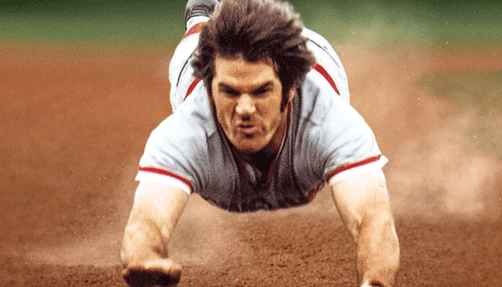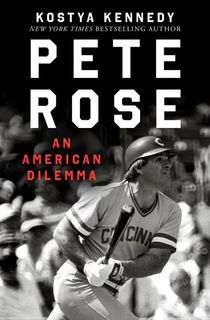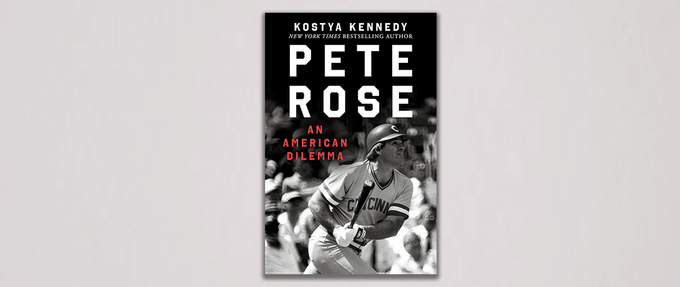Pete Rose is simultaneously one of the most famous and most controversial figures in the history of baseball. There are two imperative components in understanding his story: what he achieved throughout his career, and why he was eventually kicked out of the game.
First, his achievements: Rose was nicknamed "Charlie Hustle" because of the incredibly hard and aggressive way he played. He spent 24 years in the major leagues and got more hits than anyone else in history—4,256 hits in total. He was an MVP, won multiple World Series, and was, simply put, a baseball legend. Based on his playing record alone, he should have easily been voted into the National Baseball Hall of Fame.
Second, his controversy: In 1989, Rose, who was then a manager for the Cincinnati Reds, was banned from baseball for life. The reason? He was caught betting on games, including games involving his own team—the most serious violation a person in baseball can commit. This ban permanently bars Rose from the Hall of Fame, leaving him as the sport's greatest record-breaker exiled from its highest honor.
This complicated conflict is dissected in Kostya Kennedy's book, Pete Rose: An American Dilemma. Kennedy digs into the deeper moral question at hand: How should we, as fans, critics, and consumers, judge Pete Rose today? Kennedy explores Rose’s life, from his exciting start to his harsh battle with baseball's leadership.
The following excerpt, taken from the book's first chapter, finds Rose in Cooperstown, New York, the home of the Hall of Fame, during the annual induction weekend. While the honored heroes are being celebrated down the street, Rose sets up shop, signing autographs for cash. The excerpt captures the scene, the spectacle, and the enduring pull of Rose's complicated legacy right outside the door he is forbidden to walk through.

For a sneak peek at the controversy surrounding Pete Rose, read on—then download the book today.
Cooperstown 2012
Rose, like numerous other baseball stars, has been signing for dollars during induction weekend off and on since 1995, when he debuted at a modern Cooperstown institution called Mickey’s Place. He had originally planned to sign there in ’93—less than four years into his lifetime banishment from baseball and just two years after he was made ineligible for induction into the Hall of Fame. He canceled those first appearances, however, after objections from many in the game (including Hall of Famer and former Rose teammate Tom Seaver) who said that Rose’s joining the dozens of former big leaguers peddling their autographs in Cooperstown that weekend would, under his particular circumstances, be in bad taste. Upon deciding to stay away, Rose issued a statement saying that he didn’t want to do anything that would take away from that year’s inductee, Reggie Jackson.
After Mickey’s Place, Rose moved with Vilacky and Vilacky’s mentor and business partner, Tom Catal, to the short-lived Pete Rose Collectibles, and then, about five years ago, to Safe At Home. Still, he has not been a constant fixture. For a while in the mid 2000s, Rose believed, based upon conversations with commissioner Bud Selig and other baseball executives, that he had a chance to gain reinstatement to the game. Rose got the impression from Selig that it would be in his best interest to lie low for a while and not to do things like hold autograph sessions down the street from the Hall of Fame during induction weekend. So for a few years Rose didn’t come to town. Reinstatement, though, never happened, and the prospects that it would happen seemed to fade.
Rose, impatient and irked—pissed in the words of one person close to him—phoned Vilacky and said, “Fuck it. They’re not doing what they said they would do. I’m coming back up this year.” Over a few days of signing autographs in Cooperstown, depending upon the crowd, Rose might make $30,000 or more.
The arousal that Rose generates by his appearances during induction weekend has abated in recent years, but only slightly. He still attracts a heavy and ardent following—and generates more conversation than the other baseball greats signing their names—and this was particularly true on the late July weekend of 2012 when thousands of Cincinnati fans flooded into Cooperstown to honor the induction of shortstop Barry Larkin, who played for the Reds from 1986 through 2004. As a Cincinnati rookie, Larkin hit his first major league home run in the same game in which Rose, then the Reds’ player-manager, swung at his final big league pitch. Larkin played his first four seasons under Rose, becoming an All-Star.
“That first year we had two shortstops, Barry and Kurt Stillwell,” Rose recalled in Cooperstown the day before Larkin’s induction. “Barry came into my office one day and said, ‘Pete, Kurt is a good player, but you may as well trade him. I’m going to be your shortstop here for the next 15 years.’ We traded Stillwell the next season.” Larkin in 2012 was the first Reds player to go into the Hall of Fame since Tony Perez in ’00. (Sparky Anderson, Cincinnati’s manager for nine seasons and four World Series appearances, was also inducted that year.) Replica Larkin jerseys hung prominently in the storefront at Safe At Home all weekend, as did T-shirts that read VOTE PETE INTO THE HALL OF FAME on the front, and THE ALL-TIME HITS LEADER NOT IN COOPERSTOWN? PLEASE on the back.
Rose, per custom of the trade, commanded varying prices for his signature: on a photo or ball ($60), on a bat or jersey ($95), and so on. A personalized inscription might run an extra $20. To get the autograph you bought a ticket at the Safe At Home register, then were led outside and around back to wait in line in an alleyway behind the store. (The reason for this, as Catal, the store owner, explained while surveying the scene from the store’s front step, was so as “not to clog up all this beautiful foot traffic” on Main Street.) Complained one fan wearing a Reds’ Sean Casey jersey that Friday afternoon, ‘I went back there and checked it out. The line is too long, I’m not doing it.’ But a few minutes later he and his companions, similarly clad, had changed their minds and were standing in the line, items in hand to be signed, partially shaded from the high sun on a beautiful summer afternoon.
To each customer Rose provides generous sit-down time and excellent banter. The few minutes next to Rose is a major part of what people pay for—the monetary value of his autograph has slipped significantly after so many years of signing—and also why the line moves slowly. In effect, Rose is receiving visitors. Burly, quick-witted and genial, he never hurries people along, gently needling ("That’s a hell of a wristwatch you got there, what’d it come free with the shirt?"); answering all manner of baseball related questions (Q: “Who is the best player you ever managed?” A: “Me”); and often offering a little something more. ("Do you want to take another photo? Sure, bring both of your kids into this one.") He’ll give a young ballplayer advice ("Watch the other team’s pitcher the whole time before you come up, you’ll learn something"), and at the end of the exchange he will hold a customer’s handshake for just that extra moment. When he thanks someone for coming out he looks him straight in the eye.
Rose is not avuncular—he’s too crass and not soft enough for that; and although he is advancing deeper into the eighth decade of his life and his children have produced five children of their own, Rose is certainly not grandfatherly. In Cooperstown he wore a lightweight fedora covering up his dyed, reddish hair, and an oversized T-shirt and jeans. Also a thick gold watch. He is prone to telling crude jokes and he is not at all above saying, in mixed and even unfamiliar company, “Right now, I could use a blow job.”
There’s a scruffy sort of soulfulness about Rose, though, something genuine and to admire, and, because of his many sins and because of the strange company he sometimes keeps, there is an aura of mystery too. The broad strokes of his life story—his inspiring self-propelled rise and his astonishing self-inflicted fall—continue to render him an object of deep curiosity. Customers in the store who aren’t waiting to get autographs hover 40 feet away from his signing table, peering over and talking to one another about Pete as a hell-bent ballplayer or about his betting habit or his current romantic involvement with Kiana Kim, a former Playboy model who is more than 30 years his junior. “How much money do you think he has gambled away in his life?” someone asks another. "Millions?" There is no need to speak softly, Rose is out of earshot, but the onlookers do, heeding to a sense that they are talking about something they should not be talking about, the details of someone else’s iniquitous life. It’s a bit like the cocktail party guests standing together at Gatsby’s mansion when one woman whispers, conspiratorially, of the host, “Somebody told me they thought he killed a man once.”
Rose is hardly the only lure for autograph seekers this weekend (although he is, even now, arguably the most popular). Main Street is lined with choices. Within a single block a passerby might over the span of a few hours have the chance to get the signatures of Hall of Famers Juan Marichal, Lou Brock, Rollie Fingers, Johnny Bench, Frank Robinson, Goose Gossage and others. A restaurant is offering, just off its outdoor patio, a series of sessions with former Reds such as Eric Davis, Dave Parker and manager Lou Piniella. Big Cecil Fielder, the former Tigers slugger, has a table. There are lines for all of them. Farther down the road is a grouping of players meant to appeal to Yankees and Mets fans: Elliott Maddox, Ron Blomberg, Roy White and Howard Johnson. In front of a memorabilia store called Legends Are Forever a young woman hollers out, carny barker style, “Ernie Banks here from 1 to 4 o’clock. A Hall of Famer! Get your Ernie Banks autograph!”
The hawking of things, the sheer volume of memorabilia and all the money changing hands reveals a Cooperstown greatly altered from the quieter heather-strewn hamlet that officially welcomed its first Hall of Famers on June 12, 1939. Fifteen thousand people spilled onto the festively adorned streets that dayonto Chestnut, Railroad and Main—crowding to try to get glimpses of men like Babe Ruth, Napoleon Lajoie, Walter Johnson and Cy Young. Schoolchildren let out early on that Monday hustled about looking for autographs, but there were no signing tables, no price structures, no thoughts of resale or estimations of value beyond that value which is evident to a child holding, or showing to a friend, a scrap of paper onto which Ty Cobb, say, has just scrawled his name. Today’s scene, with collectors noisily comparing their wares, is a transformation not only from that seminal day, but also from the Cooperstown of the 1960s, ’70s and into the ’80s, before the influx of memorabilia shops and before the autograph and collectibles market went haywire.
In another sense, though, in a feeling, the Cooperstown induction experience is at its core unchanged. Baseball remains a community and on this special weekend, everyone is welcome—the all-time greats, the everyday big leaguers, the Sunday adult leaguers, the fans. Just as Yankees manager Joe McCarthy and recently retired Pirates third baseman Pie Traynor ran into each other and sat to chat on a Cooperstown bench in 1939, Hall of Famers Tony Perez and Andre Dawson stopped for an impromptu conversation in front of the Doubleday Cafe in 2012. Just as fans, come from afar and sparked by the heroes mingling among them, called out then—Hey Babe! Hey Ty!—so do they now: Hey Eck! Hey Whitey! For all its commercialism, induction weekend can still provide a fine measure of surprise and closeness, a commingling of history, legend and memory, and a prevailing spirit that draws its strength from so many baseball lives. The spirit was there when Connie Mack went in in 1939, and Jimmie Foxx in ’51 and Jackie Robinson in ’62 and Barry Larkin in 2012.
Want to keep reading? Download Pete Rose: An American Dilemma today.

Pete Rose
Featured images:
Annie Spratt / Unsplash
Everett Collection
